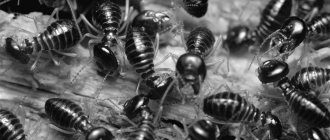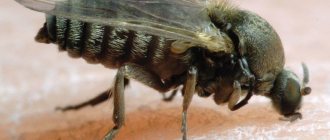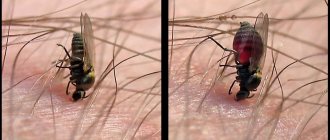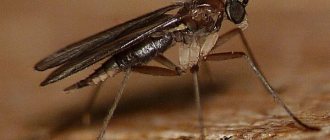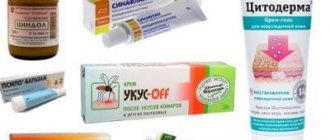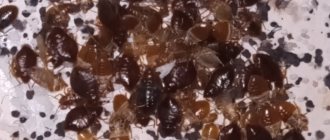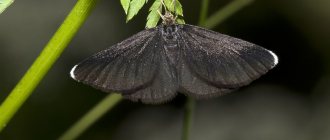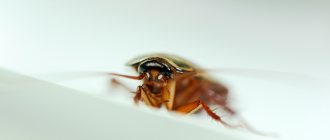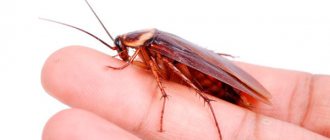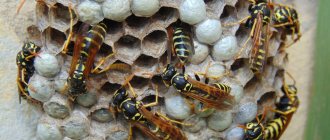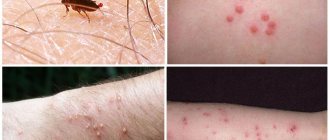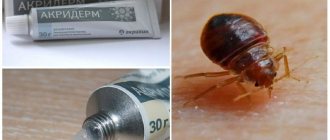The term “midges” may mean:
- Insects according to the official scientific classification, belonging to the midge family.
- Insects belonging to other families, but called midges because of their characteristic appearance and small size.
Both groups include species that are capable of drinking blood and biting people and domestic animals.
Carnivorous midges and insects similar to them in appearance and lifestyle are part of the midges - a group of blood-sucking flying pests. Depending on the area, the species composition of midges may vary, but the bite of any midge looks almost the same. The symptoms and intensity of the reaction are much more influenced by the individual characteristics of the body and immunity of the bitten person. The recommendations for first aid and treatment of midge bites described below are presented for informational purposes; only a doctor should make a diagnosis and prescribe treatment, especially for acute reactions.
Pest bite area
In general, midges do not choose where to bite their prey.
They bite wherever necessary (forehead, arms, legs, stomach), wherever they find areas of skin not covered by clothing. Despite this, they can also bite under clothing, in which case you will find bite marks on the thighs and stomach.
Places where pests accumulate are places with high humidity.
They also love hot weather. In the evenings, pests also become more active. Usually, the victims are people who spent the weekend at their summer cottage. Interesting fact
During the war, a person sentenced to execution served his sentence as food for midges. He was brought to a place where pests were concentrated, undressed and tied up. The condemned man died a painful death from numerous insect bites.
Is a midge attack dangerous?
A characteristic feature of a midge attack is severe irritation of the skin with saliva, which contains toxic substances. Midges bite off the outer layer of skin with their jaws and lubricate the wound with saliva, which includes an anesthetic substance. Therefore, initially the attack does not actually cause pain. Afterwards, the pest drinks blood and lymph, which appears on the surface of the wound.
The saliva of these insects is considered a potent hemolytic poison and includes anticoagulants, vasodilators, and enzymes that break down nutrients to facilitate its processing by pests. These components are of protein origin. They directly provoke itching, swelling, pain, inflammation and allergies. Often, after an insect bite, a leg or arm swells.
This is what bites on the face and other parts of the body may look like:
After a certain period of time, intense itching develops in the area. It continues for 3-4 days or weeks, which causes scratching and damage to the skin, in particular in a child. When a wound becomes infected, a purulent inflammatory process forms that requires long-term therapy.
Midges do not carry any diseases that are dangerous to humans. The exception will be insects living in Asia and Africa. They carry cholera, tularemia, and anthrax.
Consequences after a midge bite
The reactions that can be caused by a bite are different.
A person who has never complained of allergic reactions may also suffer. Reactions are divided into local (itching, which is unbearable, redness and subsequent swelling, if the midge has bitten the lower limbs, the person’s gait may be difficult); general (high temperature, weakness in the body, headaches. And if you have a tendency to allergic reactions, then in this case the body may become covered with blisters not only in the affected areas of the skin).
The swelling itself may go away within a few days. But the itching may torment you for several weeks. Itching can develop into scratching, which will also take a long time to heal on your body.
What signs can be used to understand the severity of a reaction to a midge bite?
Factors that will help you understand how reactions to a midge bite are expressed:
- Age range.
More mature people can easily tolerate midge bites. For children, bites can subsequently affect them in the form of an allergic reaction. Infants suffer the most danger from midge bites. For them, this can develop into a serious illness. - Immunity.
If the immune system is weakened, the reaction to a midge bite can cause allergic reactions. Age range does not matter here. - Increased sensitivity to midge saliva.
All pests contain an irritating reagent in their saliva, the body’s reaction to which cannot be predicted. If the human body is sensitive to this reagent, then insect bites must be avoided. - Pregnancy and lactation.
During pregnancy and breastfeeding, a woman’s body is weakened significantly. If before pregnancy a woman tolerated insect bites normally, then during this period there can be serious consequences.
Getting to know the insect
Midges are small insects whose size barely reaches 5 mm. Most species have completely miniature sizes - 2 mm. They live everywhere, with the exception of Antarctica. All phases of development, until the insect reaches the imago stage, midges spend in an introductory environment. The family has about 1,800 species; the European temperate climate is inhabited mainly by fruit flies, whiteflies, and sciarids. Only a knowledgeable entomologist can determine the differences between them. The poor fellow, bitten by a midge, has no time to determine the species, and all the vileness looks the same to him.
Midges
Interesting!
In most species, only female midges feed on the blood of warm-blooded insects. Males eat exclusively fruit or flower nectar.
People who live near bodies of water or travelers in the taiga and tundra are most aware of how midges bite. As experienced people say, a midge in the taiga will be worse than a mosquito. Hordes of insects are called nothing more than midges. Rivers and lakes with running water are mandatory conditions for the reproduction of insects. Females lay their eggs on plant stems and stones in ponds. Some individuals specifically go underwater to lay offspring. Other females do not bother themselves with diving skills and drop their eggs on the fly. If you take a portion of water from the bottom of a river or any other body of water, using a magnifying glass you can see tiny worm-like white larvae.
The peak of activity begins in mid-April, early May and ends only by the end of June. In the northern regions, midge activity decreases after snowfall. Insects feed only during the daytime in sunny weather. On a rainy, cloudy day, no midge activity was recorded at night. Insects live in flocks containing myriads of individuals. People and animals suffer from midge bites. There are known cases where tens of thousands of cattle died from attacks by the Colombian midge in the Danube countries.
Midges
Review
“One day in late spring, my family and I came to visit relatives living on the banks of the small river Khoper. Suspecting nothing, we decided to get out into nature and relax on the river bank. We drove up to the shore and, inspired by the view of the spring landscape, quickly got out of the car. And then it started! Swarms of small midges swarmed around us and began to bite us furiously, tiny insects getting into our mouths and noses. The child immediately ran into the car, and we adults still tried to resist. But neither running fast nor waving branches helped. I had to leave the inhospitable shore; it’s good that at least no one was allergic to the midge bite. Local residents then laughed at us and said that the midge would disappear only after the flood and the June haymaking.”
Valentina Vladimirovna, Balashov
First aid after a midge bite
If midges bite you while outdoors, you must immediately treat them with any solution that contains alcohol.
After this, treat the bite with insect repellent. Nowadays, people do not go on vacation without these funds. If a midge has bitten you at home, the first thing you need to do is treat the wound with folk remedies to prevent the development of swelling.
What antiseptics are recommended for treating a bite?
Chlorhexidine;- Miramistin;
- Boric acid;
- Furacilin solution.
To prevent the swelling from “growing,” you need to apply ice in a cloth wrap to the bite area. If you do not wrap the ice in a cloth, you may get frostbite on your skin.
We are treated with medications
It is impossible not to consider how to treat the problem with medications.
Treatment and relief of serious symptoms should only be carried out together with a doctor, as prescribed.
Each medicine has contraindications and dosages that must be followed.
Experts prescribe different treatment methods depending on the symptoms and condition of the patient.
- The wound and the area of skin near it are occasionally lubricated with ammonia. This remedy is effective if mosquito bites are present, in particular when they affect children.
- If intense itching is present, it is recommended to smear the skin with antipruritic ointment. It can be used even in childhood.
- When a pest attack triggers an allergy, antihistamines are used.
- Therapy with wound-healing ointments is possible if deep wounds have formed due to intense itching.
- Treatment with glucocorticoid ointments is acceptable.
- The use of ointments and solutions with an antiseptic effect, periodically applied to the damaged part. You can use preparations that contain iodine, hydrogen peroxide, boric acid.
- It is recommended to cover the affected area with a damp bandage. It is permissible to use Novocain and Furacilin as a therapeutic agent.
- If the temperature has increased and the inflammatory process is severe, therapy is carried out through the use of antibiotic drugs.
Relieving inflammation
Inflammation occurs when we begin to scratch the affected area.
To completely prevent inflammation, you need to take a comprehensive approach to treatment. Ointments and lotions will give you a positive effect. If it was not possible to remove the inflammation with the help of ointments and lotions, and the inflammation continues to “grow,” then the following maneuvers must be performed daily:
- Treating the wound with soapy water. It is advisable to use 72% laundry soap.
- Lubricate the irritation with any antiseptic. It is important to ensure that this product does not get into the wound itself.
- 2 hours after applying the product, lubricate the wound with ointment (levomekol, you can even use Vishnevsky ointment). It is recommended to lubricate the wound at night.
- After a while, as the ulcer formed after the bite begins to heal, you can begin to make lotions. Flocks of herbs (chamomile, sage, etc.). Wet a cloth with the solution and apply it to the wound.
Important point.
If irritation begins to worsen, consult a doctor. Of particular concern should be the appearance of black spots on the skin.
What remedies will help get rid of irritation and itching?
A midge bite causes severe itching, which can develop into nervous anxiety. How to treat it? Folk medicine and traditional remedies come to the rescue.
Ointments and gels
- Fenistil.
- Sinaflan.
- Psilo balm.
- Momederm.
- Betazon.
- Prednisolone.
- Hydrocortisone.
Regardless of their pharmaceutical affiliation, all of the above remedies will help you fight unbearable itching.
Swelling after a midge bite. How to deal with it
- Baking soda.
You will get the effect from it: it relieves swelling, lowers the pain threshold and reduces itching. How to prepare the solution? Add 1 teaspoon of soda to 250 ml of water. Wet a cotton swab with the resulting solution and wipe the infected area. - Plantain or parsley juice.
The effect will also help reduce pain and itching. - Essential oils.
It is recommended to use both in pure form and to make a solution. The method of application is the same as described above. How to prepare the solution? 1 tablespoon of vegetable oil and 5 drops of any essential oil. Also wet the swab and apply it to the infected area.
Any complications after the bite? Treatment options
Signs of complications:
- Heat;
- Headaches and dizziness;
- Formation of pustules in the affected area;
- Spots and scars appeared after the wound healed.
All these symptoms indicate that you are experiencing complications.
You can relieve fever and headache with conventional antiviral drugs (Ibuprofen, etc.). Signs of intoxication - here medications such as enterosgel, white coal will help you.
Aloe.
A folk remedy that will help you replace all pharmaceutical products and save your budget.
How to apply aloe?
Rinse the aloe leaf well and scoop out all the pulp using a spoon. Cut in half and place on a napkin. First, the wound should be treated with any antiseptic; after 15 minutes, apply an aloe leaf to the wound and tie it with a bandage.
Effect:
Aloe not only disinfects and increases wound healing time, but also relieves itching and inflammation of the wound.
If you find spots on the skin, you can use products such as: Bruise off, Badyaga and other products designed to treat bruises and abrasions.
If hardening is detected inside the wound, it is recommended to use absorbable compresses, for example, Dimexide.
Dilute it in water in a ratio of 1:4 and apply a gauze pad soaked in the solution to the cone.
This product may cause skin burns if overused. The optimal holding time is no more than 40 minutes.
If a midge bites you on the face. What to do
The favorite place for midge bites is the face and neck.
They especially like to bite in unprotected places on the body (the mouth and around the eyes). If a midge bites in these places, you will feel the effect immediately when the poison enters the blood.
The eye will immediately begin to swell, which can lead to short-term vision loss.
If the site of infection is the area of the lips, then the lip will immediately begin to enlarge and it becomes problematic to talk.
Face
– a dangerous area for pest bites. If this happens, you must immediately take measures to prevent the development of complications:
- Apply antiallergic cream to the affected area of skin. In this case, drugs from the corticosteroid group are suitable;
- It is necessary to drink as much water as possible in order to remove all toxins as quickly as possible.
- Apply a compress of grated potatoes to the sore spot. This product will help cope with itching and cool the skin;
- Parsley juice will help deal with swelling. Wash fresh herbs, chop finely, place in clean gauze and squeeze well. Apply a damp swab to the bite site.
Important point. Never rub your eyes with your hands. If the mucous membrane is inflamed, the percentage of infection penetration increases significantly.
Experts' opinion
Based on the results of clinical studies, La-Cri products, including cream for sensitive skin, are recommended by the St. Petersburg branch of the Union of Pediatricians of Russia. The effectiveness, safety and tolerability of the products have been proven by a clinical study. The cream is also suitable for daily skin care of children with mild to moderate forms of atopic dermatitis and during remission, accompanied by a decrease in the quality of life of patients. As a result of therapy, a decrease in the activity of the inflammatory process, a decrease in dryness, itching and flaking was noted.
It has been clinically proven that La Cree cream for sensitive skin reduces itching and irritation, relieves skin redness, moisturizes and gently cares for the skin.
Sources:
- I.A. Gorlanov, L.M. Leina, I.R. Milyavskaya, Skin of newborns: differential diagnosis of pathological conditions, features of care
- N.D. Odinaeva, G.V. Yatsyk, I.A. Belyaeva Correction of dry skin in newborns, Pediatrics journal, 2011
- B.A. Shamov, I.G. Safiullina, A.B. Beshimova, T.B. Shamov, Differential diagnosis of atopic dermatitis, Journal of Practical Medicine, 2011
- Fokina R.A., Atopic dermatitis: stages of development of classification forms, Siberian Medical Journal, 2007
What you should never do after a midge bite
- Household chemicals. Anything containing chemicals is strictly prohibited. The exception is laundry soap.
- If ulcers appear from scratching, they must be handled carefully. Do not allow alcohol solutions to get into open wounds.
- If a midge bites a baby. In this situation, consult a doctor immediately. Do not take self-medication, this can turn into a tragedy, since the baby does not have a strong immune system.
- Minimize scratching. If you really want to, it is also advisable to abstain. This can lead to infection in the infected area of skin.
- Corticosteroids should not be applied to an open wound. They cause a burning sensation and slow down tissue regeneration processes.
Effective and common folk methods
If you are bitten by midges, you can use folk remedies, but preferably after consulting with your doctor.
They are in every home, but must be used correctly.
Let's see what helps against bites, what home methods:
- Soda solution. To prepare the product, dissolve 1 tsp in a glass of water. soda They lubricate damaged areas. In addition, this product is applied as wet dressings, periodically soaked in this liquid.
- Toothpaste with menthol. It needs to be spread on the swelling and left for a certain time. Toothpaste can be used as a therapy for a child when there are no open wounds on the skin.
- Vinegar solution. To prepare it, you need to dilute vinegar with water in the same amount. This product is applied to the affected area or applied as a wet dressing.
- Dandelion juice. To make the product, you need to crush the plant and collect the juice using a gauze swab. It is applied to the swollen area. The tampon is secured with a gauze bandage. It is recommended to apply a fresh tampon every 2-3 hours.
- Plantain leaves. In the process of treating children when wounds appear, it is necessary to crush plantain leaves. The finished mass is applied to the area and secured with a bandage.
In what cases is it necessary to urgently consult a doctor?
It is necessary to seek medical help if:
- You have tried all the methods, but nothing helps, and the effect of infection only intensifies, you need to consult a doctor as soon as possible.
- If there is a possibility of developing anaphylactic shock, call an ambulance immediately.
- If you follow all the recommendations and do everything according to the instructions, but the symptoms do not disappear, it is also recommended to consult a doctor.
What are the dangers of skin lesions and how to treat them?
If the bite is treated incorrectly and untimely, the following complications arise:
- allergies (the appearance of a rash, nausea, weakness, fever - signs of such a reaction);
- inflammation of wounds (severe itching provokes scratching, and if infected, the damaged area festers);
- loss of vision (if bites in the eye area are treated incorrectly, there is a risk of vision loss).
To prevent complications, measures must be taken immediately. Immediately after discovering a bite you should:
- Wash the wound with water and laundry soap. You should not use other soapy products (gels, shampoos), as this may contribute to the development of allergies.
- Blot excess water with a napkin.
- Treat the wound with an antiseptic (Furacilin, Chlorhexidine).
- If the pain is intense, take a painkiller and an antihistamine (Paracetamol, Claritin, Suprastin, Tavegil).
- Cool the bite area with ice.
On a note. Netizens who have encountered a similar problem recommend applying Zvezdochka balm to the damaged area.
If the bite occurs in the eye area, you must:
- Rinse the damaged area with cold water.
- Relieve swelling with a special ointment, for example, Fenistil Gel.
- Cool it with a compress.
- You should consult a doctor as bites in the eye area are especially dangerous.
Compresses
A compress applied to the damaged area in a timely manner will greatly facilitate subsequent treatment and speed up recovery. This method will help relieve inflammation and relieve itching. There are many recipes for wet dressings, but we will focus on illustrating the most famous of them.
Dandelion compress:
- Grind the fresh leaves of the plant until the juice is released.
- Apply the resulting pulp to the bite site.
- Secure the compress with a bandage or plaster.
- Change every three hours.
In the same way, a compress is made from the leaves of parsley, plantain, and basil.
Potato:
- Take one raw potato.
- Cut into slices or grate.
- Apply to the skin and secure with a bandage.
- When the potatoes are hot, replace them with a fresh portion.
This recipe, like the previous one, is also suitable for eliminating the consequences of bites in the eye area.
Soda:
- Dilute a teaspoon of the substance in half a glass of water.
- Soak the bandage in the solution.
- Apply to the damaged area of skin.
- Keep until dry.
- If necessary, repeat the procedure.
You can also use ice and menthol products as a compress, including toothpaste, which perfectly cools the skin.
Photo gallery: ingredients of effective compresses
A compress of grated potatoes is a popular method in folk medicine for relieving skin inflammation.
Thanks to a compress of soda, severe itching is relieved in places where midges bite.
A chamomile compress will soothe and tone damaged skin.
Pharmacy drugs
Purchased anti-bite remedies are divided into three groups:
- Ointments.
- Gels.
- Creams.
They differ in consistency and speed of absorption of the active substance. Ointments and creams are made with a fatty base, which means they are absorbed slowly but remain on the skin longer. Gels have a quick effect, as they are water-based and easily absorbed.
Important to remember. Ointments and creams leave stains on clothes due to their fatty base, so they should be used carefully.
Table: characteristics of popular products with ratings based on customer reviews
| A drug | Price | Grade | Active substance | Action | Contraindications |
| Fenistil | 360 rub. | 3,9 | Dimetindene - 1 mg |
|
|
| Bepanten | 200 rub. | 4,7 | Dexpanthenol – 1 g | Tissue regeneration |
|
| Rescuer | 154 rub. | 4,8 |
| Healing | Hypersensitivity to components |
| Menovazin | 70 rub. | 4,9 |
|
|
|
| Levomekol | 130 rub. | 4,7 |
|
|
|
Photo gallery: effective drugs for treating damaged skin
Rescuer balm contains only natural ingredients
The substance dexpanthenol in Bepanten ointment heals and restores the skin
Fenistil gel has antipruritic and antiallergic effects
Treatment of the consequences of bites in children
In children, various types of symptoms are more intense than in adults. They also have a harder time not scratching their itchy skin, so there is a greater risk of wound infection.
If a child is bitten by a midge, follow these rules:
- Rinse the wound thoroughly.
- Apply a baking soda compress using a cotton pad and hold it in place for a short time. This will prevent you from scratching the bite area.
- Bathe your child with sea salt. This procedure will help relieve itching from numerous bites.
- After this, treat the patient using special means.
Important to remember. When choosing an ointment for your child, read the information on the packaging. It is necessary to use medications in accordance with the age category to which the patient belongs.
Since not all ointments are suitable for treating small children, use tea tree oil - it relieves itching and reduces irritation. While relaxing in nature, carefully monitor your baby. If he starts to itch, examine the skin for bites so that the child does not have time to scratch the damaged area.
If swelling and redness are severe, consult a therapist or allergist. Self-medicating in this situation is dangerous, because children's immune system is weak, which makes the risk of complications higher.
Video: helping a child with midge and mosquito bites
What to do if signs of allergy appear
Children, pregnant and lactating women, as well as people predisposed to such reactions are susceptible to developing allergies.
Signs:
- polymorphic rash, characterized by the appearance of heterogeneous spots;
- acute erythema - a sensation of dense nodes under the skin, up to 5 cm in diameter;
- increasing swelling of the tissue at the site of the bite.
What to do:
- Relieve swelling with ointments or compresses.
- Take an antihistamine.
- If signs of swelling do not disappear within a day, you should consult a doctor.
Rarely, after a bite, anaphylactic shock occurs or Quincke syndrome (extensive swelling of the skin) develops. In such cases, it is necessary to urgently consult a doctor, as there is a risk of death or coma.
Signs of anaphylactic shock are as follows:
- pressure drop;
- convulsions;
- uncontrolled urination;
- loss of consciousness;
- heat;
- headache;
- intense local reaction.
Quincke syndrome is characterized by the following symptoms:
- enlargement and swelling of soft tissues;
- the swollen area feels hard to the touch;
- after pressing on the bite, a hole remains;
- pale skin;
- decreased blood pressure;
- tachycardia (rapid heartbeat);
- intense sweating;
- confusion;
- lack of coordination;
- anxiety, fear.
Important to remember. Treatment must be prescribed by a doctor. Trying to solve a problem on your own is dangerous and can be fatal, as can failing to seek help in a timely manner.
Photo gallery: allergic reactions to midge bites
The development of anaphylactic shock can occur over a period of several seconds to 5 hours
Quincke's edema due to insect bites occurs only in 2% of cases
In 20% of cases, anaphylactic shock is fatal
How to avoid midge bites
Midges bite unnoticed and it is not always possible to feel their bite, so if you know that you are going to travel to nature or to the country, be sure to take precautions:
- Don't wear perfume. This attracts midges.
- Dress to show as little skin as possible.
- It is better to wear clothes made from natural fabrics.
- Apply products that repel midges. Please read the instructions before applying.
- The smell of food also attracts pests. When you sit down to eat, be sure to cover as much of your body as possible with clothing.
If you live in an apartment or house, you can also become victims of midges.
This is where electric fumigators will come to your aid.
If you take all protective measures, then you will not be afraid of any pests and the summer will pass 100%.
Description of the appearance of a bloodsucker under a microscope
Those who managed to see a photo of a mosquito under a microscope clearly state that it looks scary and repulsive. His body no longer looks as smooth as it seems. It is all covered with small bristles. With their help, he orients himself in space and establishes a connection with the surrounding world.
Most noteworthy is the head, which in photographs under a microscope looks like something alien. The first thing that catches your eye when looking at it is the large mosaic eyes. The structure of the visual organ under a microscope looks very interesting. These are many small fragments that together make up a whole faceted eye.
The structure of the oral apparatus also attracts no less attention. An enlarged mosquito has a developed and branched apparatus
It consists of the upper and lower lips, jaws and proboscis. Even the nose of a mosquito is not a strong needle, but several flexible tentacles. It is with their help that the bloodsucker finds a blood vessel under the skin.
The midge is considered the most common insect on Earth. When magnified under a microscope, the midge looks somewhat like a fly. Its size, on average, is 2 - 3 millimeters, with an isolated case when the dimensions reach 6 mm. The body of the insect is gray. After biting a person or animal, the midge becomes saturated with blood and its body changes to a reddish hue. The midge has a curved chest covered with small hairs.
The abdominal cavity is a single system consisting of 9 segments. On the outer part of the midge body there is a pair of fairly large wings. If you look closely, you can see dark patterns on the wings, giving the midge a grayish color. Thick and densely packed veins are covered with small fibers over the entire area. The paws are dense and small like those of a midge. One pair of legs is located in the upper part of the abdomen, and the other two, bent and covered with villi, are located in the lower part. The head of the midge is always turned down, many antennae are visible. The eyes occupy a large area of the insect's head, being located on the side.
